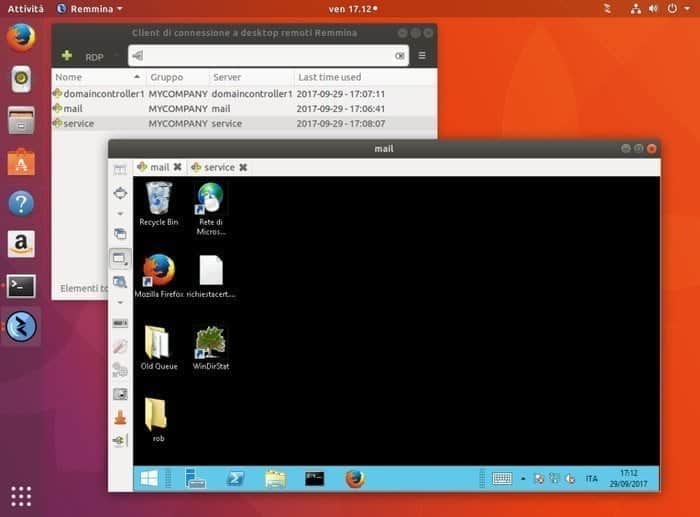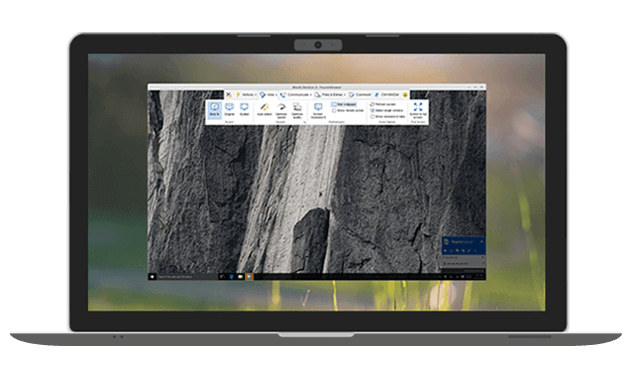Apr 27, 2021 Jump Desktop is easily one of the slickest and easiest to use remote desktop solutions for Mac users with a dedicated Mac client. Remote networking can be a complicated affair but it’s clear the developer has gone to a lot of effort to make remote desktop connections easy enough for anyone to use without sacrificing features and stability. For remote computer tracking, that is, recording videos of an employee’s computer desktop and viewing his history of work activities How does the remote connection work? Grabber, a piece of software which allows remote management, must be installed on every employee’s computer. RDP works in a client/server model, where the remote computer must have RDP server software installed and running, and a user employs RDP client software to connect to it, to manage the remote desktop computer. In this article, we will share a list software for accessing a remote Linux desktop: the list starts off with VNC applications. That is why most servers are managed through remote desktop. There are many ways to use remote desktop for your needs. This article will show you how to set up a remote desktop in Linux. Remote Desktop in Linux. There are several different ways to set up a remote desktop in Linux. As for CLI, SSH is probably the best method to use for this. May 12, 2010 It is possible to connect from Mac and Linux to Remote Desktop using UAG RD Client Tunneling template. There are several project that succeeded doing so. Can you open this remote desktop from Max and Linux without UAG, when they are on-corpnet? BTW: AFAIK, there is no RD client for Mac and Linux that support RemoteApp.
If you are a support engineer or a system administrator, it must be your routine to come across situations in which you need to troubleshoot different machines and resolve the issues with them so that their users can continue doing their work smoothly. However, there are situations when you do not have the physical access to such problematic devices i.e. you might be residing somewhere else at the time when the problem occurred with a system and it is impossible for you to visit it physically. In such situations, all you need is a remote desktop client with which you can gain complete access to a remotely located machine and can resolve its issues. Therefore, in this article, we will be sharing with you the three best Linux Mint 20 remote desktops.
Three Best Linux Mint 20 Remote Desktops:
Following are the three best Linux Mint 20 remote desktops:
Remmina:
Remmina is a remote desktop client specifically designed for all the different flavors of the Linux operating system including Linux Mint 20. It fully supports the Remote Desktop Protocol (RDP) and Secure Shell (SSH) Protocol to enable you to access the remote servers with the utmost convenience. The best thing about this remote desktop client is that it is free and open-source. Apart from that, it provides support for around 28 different languages which increases its usability. Remmina is capable of remembering the last view mode for each connection.
It provides you with a dedicated Screenshots folder in which you can safely keep all your screenshots. It also prevents screenshots that you have taken from entering into the clipboard. It allows you to configure its resolution according to your specific needs. Along with that, you can also do Tab Configuration and Host Key Configuration. Another feature which is a plus point of this remote desktop client is that it sends periodic usage reports to Remmina developers so that they are well aware of all the potential issues and can resolve them timely. Apart from these basic features, Remmina also provides other features for specific plugins that you can enjoy simply by enabling that particular plugin.
Vinagre:
Vinagre is another free and open-source remote desktop client developed for the Gnome desktops. This Remote desktop client is so efficient that it allows users to view multiple systems simultaneously i.e. you can remotely control multiple machines at a time. Moreover, its interface can be used in more than 40 different languages which makes it all the more versatile. It also allows you to keep a track of your most-used connections as well as your recent connections to increase reusability.
Because of the Gnome Keyring feature, you do not have to provide your password every time you make a connection. Vinagre provides efficient SSH tunneling and API support telepathy. If you want to make your remote desktop client able to listen to new connection requests, you can even turn on the listener mode of Vinagre. You can even add optional dependencies to this remote desktop client for using additional features. Moreover, Vinagre also enables you to chat with its developers so that you can get all your issues resolved on the go.
TeamViewer:
Teamviewer is a highly cross-platform remote desktop client which is designed for the Linux, Mac, Windows, Chrome OS, iOS, Android, and Raspberry Pi operating systems. It enables you to establish incoming and outgoing connections between different remote devices. It provides you with real-time accessibility and support. The basic version of this remote desktop client is free which makes it very popular among users. However, it also has three different paid versions with more advanced features. Moreover, the best thing about this remote desktop client is that no lengthy installation processes are required before using it i.e. you can simply download it and start using it right away.
Teamviewer is an ideal solution for remote monitoring and server management. It provides ad-hoc support for clients and employees. It offers custom branding for support applications. Teamviewer even allows us to add sticky notes to remote computers for providing further assistance to the users. It allows secure and flexible file-sharing options. It also provides the black screen feature for private remote access. You can even view the system diagnostics report on your Teamviewer desktop application. In a nutshell, this remote desktop client proves itself to be the one integrated solution for all your remote connectivity needs.
Conclusion:
By installing any of the three remote desktop clients on your system, you can remotely control any device while using Linux Mint 20. Hence you can conveniently get your issues resolved within no time.
-->Applies To: Windows 10, Windows 8.1, Windows Server 2012 R2, Windows Server 2016
You can use the Remote Desktop client for Mac to work with Windows apps, resources, and desktops from your Mac computer. Use the following information to get started - and check out the FAQ if you have questions.
Note
- Curious about the new releases for the macOS client? Check out What's new for Remote Desktop on Mac?
- The Mac client runs on computers running macOS 10.10 and newer.
- The information in this article applies primarily to the full version of the Mac client - the version available in the Mac AppStore. Test-drive new features by downloading our preview app here: beta client release notes.
Get the Remote Desktop client
Follow these steps to get started with Remote Desktop on your Mac:
- Download the Microsoft Remote Desktop client from the Mac App Store.
- Set up your PC to accept remote connections. (If you skip this step, you can't connect to your PC.)
- Add a Remote Desktop connection or a remote resource. You use a connection to connect directly to a Windows PC and a remote resource to use a RemoteApp program, session-based desktop, or a virtual desktop published on-premises using RemoteApp and Desktop Connections. This feature is typically available in corporate environments.
What about the Mac beta client?
We're testing new features on our preview channel on AppCenter. Want to check it out? Go to Microsoft Remote Desktop for Mac and select Download. You don't need to create an account or sign into AppCenter to download the beta client.
If you already have the client, you can check for updates to ensure you have the latest version. In the beta client, select Microsoft Remote Desktop Beta at the top, and then select Check for updates.

Add a workspace
Subscribe to the feed your admin gave you to get the list of managed resources available to you on your macOS device.
To subscribe to a feed:
- Select Add feed on the main page to connect to the service and retrieve your resources.
- Enter the feed URL. This can be a URL or email address:
- This URL is usually a Windows Virtual Desktop URL. Which one you use depends on which version of Windows Virtual Desktop you're using.
- For Windows Virtual Desktop (classic), use
https://rdweb.wvd.microsoft.com/api/feeddiscovery/webfeeddiscovery.aspx. - For Windows Virtual Desktop, use
https://rdweb.wvd.microsoft.com/api/arm/feeddiscovery.
- For Windows Virtual Desktop (classic), use
- To use email, enter your email address. This tells the client to search for a URL associated with your email address if your admin configured the server that way.
- This URL is usually a Windows Virtual Desktop URL. Which one you use depends on which version of Windows Virtual Desktop you're using.
- Select Subscribe.
- Sign in with your user account when prompted.
After you've signed in, you should see a list of available resources.
Once you've subscribed to a feed, the feed's content will update automatically on a regular basis. Resources may be added, changed, or removed based on changes made by your administrator.
Remote Desktop Client For Mac To Linux
Export and import connections
You can export a remote desktop connection definition and use it on a different device. Remote desktops are saved in separate RDP files.
To export an RDP file:

- In the Connection Center, right-click the remote desktop.
- Select Export.
- Browse to the location where you want to save the remote desktop RDP file.
- Select OK.
To import an RDP file:
- In the menu bar, select File > Import.
- Browse to the RDP file.
- Select Open.
Add a remote resource
Remote resources are RemoteApp programs, session-based desktops, and virtual desktops published using RemoteApp and Desktop Connections.
- The URL displays the link to the RD Web Access server that gives you access to RemoteApp and Desktop Connections.
- The configured RemoteApp and Desktop Connections are listed.
Remote Desktop Client For Mac To Linux Mac
To add a remote resource:
- In the Connection Center select +, and then select Add Remote Resources.
- Enter information for the remote resource:
- Feed URL - The URL of the RD Web Access server. You can also enter your corporate email account in this field – this tells the client to search for the RD Web Access Server associated with your email address.
- User name - The user name to use for the RD Web Access server you are connecting to.
- Password - The password to use for the RD Web Access server you are connecting to.
- Select Save.
The remote resources will be displayed in the Connection Center.
Connect to an RD Gateway to access internal assets
A Remote Desktop Gateway (RD Gateway) lets you connect to a remote computer on a corporate network from anywhere on the Internet. You can create and manage your gateways in the preferences of the app or while setting up a new desktop connection.
To set up a new gateway in preferences:
- In the Connection Center, select Preferences > Gateways.
- Select the + button at the bottom of the table Enter the following information:
- Server name – The name of the computer you want to use as a gateway. This can be a Windows computer name, an Internet domain name, or an IP address. You can also add port information to the server name (for example: RDGateway:443 or 10.0.0.1:443).
- User name - The user name and password to be used for the Remote Desktop gateway you are connecting to. You can also select Use connection credentials to use the same user name and password as those used for the remote desktop connection.

Manage your user accounts
When you connect to a desktop or remote resources, you can save the user accounts to select from again. You can manage your user accounts by using the Remote Desktop client.
To create a new user account:
- In the Connection Center, select Settings > Accounts.
- Select Add User Account.
- Enter the following information:
- User Name - The name of the user to save for use with a remote connection. You can enter the user name in any of the following formats: user_name, domainuser_name, or user_name@domain.com.
- Password - The password for the user you specified. Every user account that you want to save to use for remote connections needs to have a password associated with it.
- Friendly Name - If you are using the same user account with different passwords, set a friendly name to distinguish those user accounts.
- Select Save, then select Settings.
Customize your display resolution
You can specify the display resolution for the remote desktop session.
- In the Connection Center, select Preferences.
- Select Resolution.
- Select +.
- Enter a resolution height and width, and then select OK.
To delete the resolution, select it, and then select -.
Displays have separate spaces
If you're running macOS X 10.9 and have disabled Displays have separate spaces in Mavericks (System Preferences > Mission Control), you need to configure this setting in the Remote Desktop client using the same option.
Drive redirection for remote resources
Drive redirection is supported for remote resources, so that you can save files created with a remote application locally to your Mac. The redirected folder is always your home directory displayed as a network drive in the remote session.
Note
In order to use this feature, the administrator needs to set the appropriate settings on the server.
Use a keyboard in a remote session
Mac keyboard layouts differ from the Windows keyboard layouts.
- The Command key on the Mac keyboard equals the Windows key.
- To perform actions that use the Command button on the Mac, you will need to use the control button in Windows (for example Copy = Ctrl+C).
- The function keys can be activated in the session by pressing additionally the FN key (for example, FN+F1).
- The Alt key to the right of the space bar on the Mac keyboard equals the Alt Gr/right Alt key in Windows.
By default, the remote session will use the same keyboard locale as the OS you're running the client on. (If your Mac is running an en-us OS, that will be used for the remote sessions as well.) If the OS keyboard locale is not used, check the keyboard setting on the remote PC and change it manually. See the Remote Desktop Client FAQ for more information about keyboards and locales.
Support for Remote Desktop gateway pluggable authentication and authorization
Windows Server 2012 R2 introduced support for a new authentication method, Remote Desktop Gateway pluggable authentication and authorization, which provides more flexibility for custom authentication routines. You can now try this authentication model with the Mac client.
Important
Custom authentication and authorization models before Windows 8.1 aren't supported, although the article above discusses them.
To learn more about this feature, check out https://aka.ms/paa-sample.
Tip
Questions and comments are always welcome. However, please do NOT post a request for troubleshooting help by using the comment feature at the end of this article. Instead, go to the Remote Desktop client forum and start a new thread. Have a feature suggestion? Tell us in the client user voice forum.